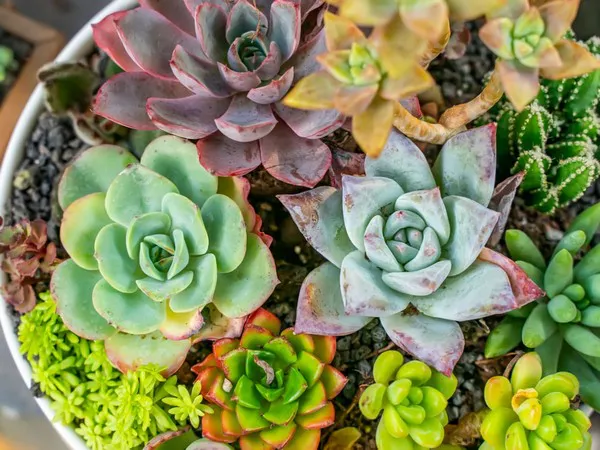Succulents, with their striking shapes and diverse colors, have gained immense popularity in recent years, becoming the darlings of indoor and outdoor gardening. Their remarkable resilience and low-maintenance nature make them the ideal choice for both beginners and experienced plant enthusiasts. However, the key to successfully caring for succulents lies in understanding how to water them properly.
Understanding Succulent Watering Needs
Succulents have adapted to thrive in arid environments where water is scarce. Their leaves, stems, or roots store water, allowing them to withstand drought conditions. To maintain the health of your succulent plants, it’s crucial to appreciate their specific watering requirements.
1. Adequate Drainage is Essential
Succulents are highly sensitive to overwatering. To prevent their roots from sitting in water and developing root rot, it’s crucial to use pots with drainage holes. These holes allow excess water to escape, keeping the soil from becoming waterlogged. Proper drainage is one of the fundamental requirements for successful succulent care.
2. The Drench-and-Dry Method
The drench-and-dry method is the preferred watering technique for succulents. It involves saturating the soil thoroughly, allowing excess water to escape through the drainage holes, and then letting the soil dry out before watering again. This method replicates the natural cycle of rainfall in arid regions, where succulents are accustomed to receiving infrequent but heavy downpours.
3. Water Quality Matters
Succulents are sensitive to the quality of water they receive. Tap water often contains salts and minerals that can accumulate in the soil over time, leading to mineral buildup. To combat this, it’s advisable to use filtered or distilled water when watering your succulents to minimize the risk of salt and mineral deposits.
4. Observe Seasonal Changes
Succulent watering needs can vary throughout the year. In their active growing season, typically spring and summer, succulents require more water. However, during their dormant phase in fall and winter, they need less. Adjust your watering frequency accordingly, keeping in mind that different succulent species may have slightly different schedules.
5. Monitor Environmental Factors
Environmental factors, such as humidity and temperature, can influence the rate at which succulents absorb and lose water. In high-humidity regions, succulents may require less frequent watering, while in dry, arid climates, more frequent watering may be necessary. Be sure to consider your specific local conditions when determining your watering schedule.
The Best Practices for Succulent Watering
To ensure your succulents flourish, here are the best practices for watering:
1. Test the Soil Moisture
Before watering your succulents, perform the “finger test.” Stick your finger about an inch into the soil. If it feels dry at that depth, it’s time to water. If the soil still feels slightly damp, wait a few days before testing again.
2. Water the Soil, Not the Plant
When watering succulents, aim to moisten the soil rather than drenching the plant itself. Pour water near the base of the succulent, allowing it to be absorbed by the roots. Avoid getting water on the leaves, as this can lead to rot and other issues.
3. Use the Right Watering Container
Selecting an appropriate watering container is crucial. A narrow-spouted watering can or a squeeze bottle is ideal for directing water precisely where it’s needed and avoiding splashing the foliage.
4. Avoid Watering on a Strict Schedule
Resist the temptation to water your succulents on a set schedule, such as every week. Instead, monitor the soil moisture and adjust your watering frequency based on the individual needs of each succulent and the environmental conditions in your location.
5. Be Mindful of the Pot Size
Succulents in larger pots will require less frequent watering compared to those in smaller containers. The larger volume of soil retains moisture for a longer duration, reducing the frequency of watering.
Common Watering Mistakes to Avoid
When it comes to succulent care, there are several common watering mistakes to avoid:
1. Overwatering
Overwatering is one of the most significant threats to succulents. It can lead to root rot, weakened plants, and even death. Always ensure that the soil dries out between watering, following the drench-and-dry method.
2. Underwatering
While succulents are drought-tolerant, underwatering can also harm them. Prolonged neglect can cause their leaves to wrinkle and wilt. Be attentive to the soil moisture and water when necessary.
3. Watering from Above
Watering from above and letting water sit on the leaves can cause rot and other issues. Always water the soil directly at the base of the plant to avoid splashing on the foliage.
4. Ignoring Seasonal Changes
Failing to adjust your watering schedule according to the changing seasons can lead to overwatering during the dormant phase or underwatering during the growing season. Pay attention to environmental factors and the specific needs of your succulents.
5. Using the Wrong Soil Mix
Succulents require well-draining soil to prevent waterlogging. Using a standard potting mix or soil that retains too much moisture can be detrimental to your succulents. Choose a specialized succulent or cactus mix or amend the soil with perlite or sand for improved drainage.
Conclusion
Successfully caring for succulents starts with mastering the art of proper watering. By understanding the unique needs of these water-storing plants and following best practices like using well-draining soil, employing the drench-and-dry method, and adjusting your watering schedule based on seasonal and environmental factors, you can ensure that your succulents thrive. Remember to monitor your plants, test the soil moisture, and avoid common watering mistakes to maintain healthy, vibrant succulent displays in your garden or home. With the right approach, you can enjoy the beauty and resilience of succulents for years to come.


